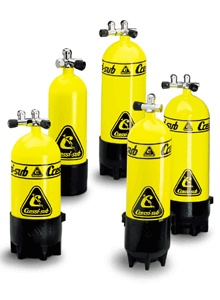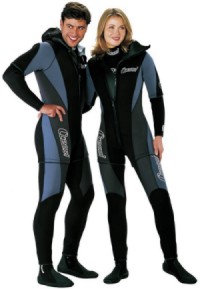Home
Scuba Diving Equipment
Scuba Diving Links

Equipment needed for a successful scuba dive includes:
Fins
Fins provide the scuba diver with a way to move through the water easily. Fins come in two varieties- the full foot and open healed. The size of the fin purchased will determine the propulsion and stiffness.
Fins come in two varieties- the full foot and open healed. The size of the fin purchased will determine the propulsion and stiffness.
Snorkel & Mask
A mask allows you to see underwater objects clearly while underwater. To prevent a mask from fogging, you should spit into it and rub it around and rinse with water.  A snokel enables you to breathe normally while on the surface. You don't use the snorkel while actually scuba diving, but it is necessary to have just in case of emergencies.
A snokel enables you to breathe normally while on the surface. You don't use the snorkel while actually scuba diving, but it is necessary to have just in case of emergencies.
Regulator
This mechanical device delivers air on demand to the scuba diver. There are two parts to a regulator.  The first stage breaks down the pressure in the tank and delivers air to the 2nd stage through a low pressure hose. The 2nd stage further reduces the pressure into air you can breathe. This picture is the the 2nd stage of the regulator and is the piece of equipment you breathe out of to recieve air. Along with the regulator you should have other hoses such as an alternate air source, called an octopus regulator, and gauges which tell you depth, bottom time, direction and air supply.
The first stage breaks down the pressure in the tank and delivers air to the 2nd stage through a low pressure hose. The 2nd stage further reduces the pressure into air you can breathe. This picture is the the 2nd stage of the regulator and is the piece of equipment you breathe out of to recieve air. Along with the regulator you should have other hoses such as an alternate air source, called an octopus regulator, and gauges which tell you depth, bottom time, direction and air supply.
Scuba Cylinders
These are also called bottles or tanks and are regulated by the Department of Transportation in the USA. The air contained in tanks is highly compressed air and the tanks can be made out of aluminum or steel.  Tanks are required to be visually inspected yearly and have hydrostatic testing done every five years. Accessories for a tank include a tank boot which helps protect the bottom, a plastic net to protect the paint and a dual manifold which hooks two cylinders together.
Tanks are required to be visually inspected yearly and have hydrostatic testing done every five years. Accessories for a tank include a tank boot which helps protect the bottom, a plastic net to protect the paint and a dual manifold which hooks two cylinders together.
Buoyancy Control Device (BCD)
Also known as a buoyancy compensator.  Features include pockets, cumberbund, octopus hose retainer, power inflator and the backpack. BCD's can come in three types; jacket, back mounted and horse. This device helps to control your buoyancy while underwater.
Features include pockets, cumberbund, octopus hose retainer, power inflator and the backpack. BCD's can come in three types; jacket, back mounted and horse. This device helps to control your buoyancy while underwater.
Diving Suit (if the water is cold enough)
 It is important to wear a wetsuit in all waters but the warmest. The amount of insulation one needs is determined by the water temperature, the activity level of the dive and a person's build. Three types of diving suits include Dive Skins, Wetsuits, and Dry Suits. Dive skins are undergarments for tropical waters. Wetsuits are made of neophrene and are for use for temperatures ranging from 55-85. Dry suits require specialized training and are for cold water ranging from 55 and below.
It is important to wear a wetsuit in all waters but the warmest. The amount of insulation one needs is determined by the water temperature, the activity level of the dive and a person's build. Three types of diving suits include Dive Skins, Wetsuits, and Dry Suits. Dive skins are undergarments for tropical waters. Wetsuits are made of neophrene and are for use for temperatures ranging from 55-85. Dry suits require specialized training and are for cold water ranging from 55 and below.
Weight Belt
These are used to offset the buoyancy of your body and a wetsuit (if worn). They come in forms such as soft weights that fit inside a BCD, hard weights which are attached to a belt which goes around the waist or wrist/ankle weights which attach around the wrist or ankle of the diver.
Dive Watch
This is considered an additional instrument and is used to time dives and keep track of how long one is under the water.
Dive Slate & Dive Tables (Optional)
 Dive tables are helpful to plan out your dive to know how long you can stay at a certain depth. Dive slates are basically a board you can write on underwater to communicate with your buddy.
Dive tables are helpful to plan out your dive to know how long you can stay at a certain depth. Dive slates are basically a board you can write on underwater to communicate with your buddy.
Diving Knife (Optional)
 A knife is used for emergencies such as getting out of a restrictive environment or for use against predators while diving.
A knife is used for emergencies such as getting out of a restrictive environment or for use against predators while diving.


 Fins come in two varieties- the full foot and open healed. The size of the fin purchased will determine the propulsion and stiffness.
Fins come in two varieties- the full foot and open healed. The size of the fin purchased will determine the propulsion and stiffness.
 A snokel enables you to breathe normally while on the surface. You don't use the snorkel while actually scuba diving, but it is necessary to have just in case of emergencies.
A snokel enables you to breathe normally while on the surface. You don't use the snorkel while actually scuba diving, but it is necessary to have just in case of emergencies.
 The first stage breaks down the pressure in the tank and delivers air to the 2nd stage through a low pressure hose. The 2nd stage further reduces the pressure into air you can breathe. This picture is the the 2nd stage of the regulator and is the piece of equipment you breathe out of to recieve air. Along with the regulator you should have other hoses such as an alternate air source, called an octopus regulator, and gauges which tell you depth, bottom time, direction and air supply.
The first stage breaks down the pressure in the tank and delivers air to the 2nd stage through a low pressure hose. The 2nd stage further reduces the pressure into air you can breathe. This picture is the the 2nd stage of the regulator and is the piece of equipment you breathe out of to recieve air. Along with the regulator you should have other hoses such as an alternate air source, called an octopus regulator, and gauges which tell you depth, bottom time, direction and air supply.
 Tanks are required to be visually inspected yearly and have hydrostatic testing done every five years. Accessories for a tank include a tank boot which helps protect the bottom, a plastic net to protect the paint and a dual manifold which hooks two cylinders together.
Tanks are required to be visually inspected yearly and have hydrostatic testing done every five years. Accessories for a tank include a tank boot which helps protect the bottom, a plastic net to protect the paint and a dual manifold which hooks two cylinders together.
 Features include pockets, cumberbund, octopus hose retainer, power inflator and the backpack. BCD's can come in three types; jacket, back mounted and horse. This device helps to control your buoyancy while underwater.
Features include pockets, cumberbund, octopus hose retainer, power inflator and the backpack. BCD's can come in three types; jacket, back mounted and horse. This device helps to control your buoyancy while underwater.
 It is important to wear a wetsuit in all waters but the warmest. The amount of insulation one needs is determined by the water temperature, the activity level of the dive and a person's build. Three types of diving suits include Dive Skins, Wetsuits, and Dry Suits. Dive skins are undergarments for tropical waters. Wetsuits are made of neophrene and are for use for temperatures ranging from 55-85. Dry suits require specialized training and are for cold water ranging from 55 and below.
It is important to wear a wetsuit in all waters but the warmest. The amount of insulation one needs is determined by the water temperature, the activity level of the dive and a person's build. Three types of diving suits include Dive Skins, Wetsuits, and Dry Suits. Dive skins are undergarments for tropical waters. Wetsuits are made of neophrene and are for use for temperatures ranging from 55-85. Dry suits require specialized training and are for cold water ranging from 55 and below.
 Dive tables are helpful to plan out your dive to know how long you can stay at a certain depth. Dive slates are basically a board you can write on underwater to communicate with your buddy.
Dive tables are helpful to plan out your dive to know how long you can stay at a certain depth. Dive slates are basically a board you can write on underwater to communicate with your buddy.
 A knife is used for emergencies such as getting out of a restrictive environment or for use against predators while diving.
A knife is used for emergencies such as getting out of a restrictive environment or for use against predators while diving.